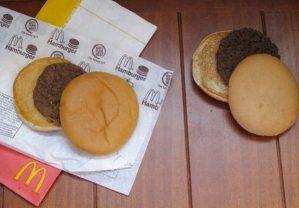Source: bigkingken.wordpress.com
Food preservatives are a common part of everyday life for those Americans who don’t go to extremes to avoid them. Twinkies will be around for thousands of years despite the dissolution of Hostess and I’m pretty sure there’s an unspoiled Big Mac somewhere that’s been hanging out for several decades.

Besides grossly keeping the hamburger on the left untarnished for more than a decade, food preservatives might be an untapped resource in the fight against cancer.
In short, food preservatives work by killing off any and all microbial life forms that come along to munch on the food before us humans have a chance to send it down to our bellies. Now, if these food preservatives are so effective at killing off unwanted bacteria in our food supplies, could they perhaps also be effective at killing off other unwanted life forms?
This is a question being asked by a lot of medical researchers at the moment, with at least one group finding an answer in the affirmative. Recently, researchers at the University of Michigan found that the common food preservative Nisin also does an excellent job of holding off – and even shrinking – the most common and deadly form of oral cancer, squamous cell head and neck cancer (HNSCC).
HNSCC is a particularly nasty form of cancer, seeing as it accounts for more than 90 percent of oral cancers yet hasn’t had its mortality rates improved in the past several decades. On the other side, Nisin is a particularly nasty strain of food preservative, in the sense that it is extremely deadly to unwanted bacteria. Approved for human consumption by the World Health Organization in 1969 and the FDA in 1988, about 0.6 mg of the substance is consumed per person per day.
So you might say that it is rather prevalent around the world.
Of course, the tiny amounts ingested on a daily basis isn’t near enough to fight off any other form of disease on its own. To figure out if it might have any pharmaceutical properties – especially to cancers – researchers pumped up the volume to the limits of tolerable exposure.
When introduced to food-borne bacteria, Lisin works by attacking the cell membranes that keep the outside world out of the cell and the guts of the cell safely tucked away. Once holes and pores are opened, it is open season for unregulated ions to flow in and out of the cell, effectively destroying the normal processes of life that rely on strictly managed comings and goings of life’s basic elements.
When introduced to rats with HNSCC, however, the effects aren’t quite as clear. From the initial studies, the substance certainly does something – namely killing off cancerous cells while also preventing tumors from spreading or growing. It’s the how that is the question.
At the moment, researchers speculate that it works in much the same way as it does in our food hordes – by disrupting the flow of calcium through the cell membrane. What’s more, it only does this to cancerous cells, due to intrinsic structural difference between them and normal, healthy cells. Another theory is that the food preservative somehow activates a protein called CHAC1 that is one of the main regulators of apoptosis – the pushing of a cell’s natural self-destruct button.
As you might expect, further studies are needed to delineate what exactly the cause of cancer cell cadavery is. But you can be sure there are plenty of people working on it mving forward, and also checking into other forms of food preservatives to see if they might be beneficial in other ways.
The study “Nisin, an apoptogenic bacteriocin and food preservative, attenuates HNSCC tumorigenesis via CHAC1” was conducted by Yvonne Kapila, professor at the University of Michigan School of Dentistry.

Leave A Comment
You must be logged in to post a comment.